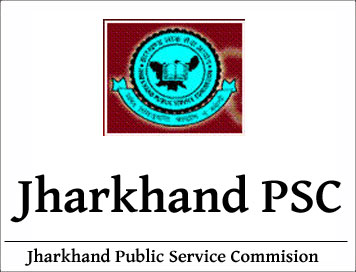
(Download) Jharkhand PSC (JPSC): Prelims General Studies Exam Paper 2 - 201 (SET-A)
- State: Jharkhand (JPSC)
- Subject: General Studies Paper-2
- Exam Date: 2014
- SET : A
- File Type: PDF
Directions for Q. Nos. 1 and 2:In each of the two questions, three out of the four sets of numbers follow the same pattern. You have to find the set that does not follow the pattern of the other three.
1. (A) 3(58)7
(B) 1(10)3
(C) 2(20)4
(D) 5(51)6
2. (A) 8(39)5
(B) 7(48)1
(C) 5(17)2
(D) 914536
Directions for Q. Nos. 3 and 4 : Arrange the five given words (1-5) in a meaningful logical order and then select the appropriate sequence from the alternatives (A), (B), (C) and (D) provided below the group of words.
3. 1. Poverty; 2. Population; 3. Death; 4. Unemployment; 5. Disease.
(A) 3, 4, 2, 5, 1
(B) 2, 4, 1, 5, 3
(C) 2, 3, 4, 5, 1
(D) 1, 2, 3, 4, 5
4. 1. Punishment; 2. Prison; 3. Arrest; 4. Crime; 5. Judgement.
(A) 5,1, 2, 3, 4
(B) 4,3,5,2,1
(C) 4, 3, 5, 1, 2
(D) 2, 3, 1, 4, 5
5. Replace the sign (?) in the following sequence of numbers with appropriate alternative :
42:56::110:(?)
(A)132
(B) 136
(C) 140
(D) 18
6.Three out of the following four pairs of numbers have the same relationships. Find the odd man out.
(A) 4, 63
(B) 1,0
(C) 2,15
(D) 5,124
7. Three of the following four groups of letters contain letters of the alphabet placed in a particular form. Find the one that does not belong to the group.
(A) LNJ
(B) RTP
(C) NPK
(D) FHD
8.Three of the following four numbers are alike in a certain way and so form a group. Which is the one that does not belong to the group?
(A) 125
(B) 216
(C) 729
(D) 525
9. If TEMPLE is coded as VHQURL, how would you code CHURCH?
(A) EKYWIO
(B) EKUWIO
(C) EKYWIN
(D) EKYWJO
10. There are five friends-Sunil, Kamal, Manish, Anil and Raman. Sunil is shorter than Kamal, but taller than Raman. Manish is the tallest. Anil is little shorter than Kamal and little taller than Sunil. Who has two persons taller and two persons shorter than him?
(A) Raman
(B) Sunil
(C) Kamal
(D) Anil
Directions for Q. Nos. 11 to 13 : These questions are based on the information given below :
Four ladies A, B, C, D and four gentlemen E, F, G, H are sitting in a circle round a table facing each other under the following arrangement :
(i) No two ladies or two gentlemen are sitting side by side.
(ii) C, who is sitting between G and E, is facing D.
(iii) F is between D and A and is facing G.
(iv) H is to the right of B.
11.Who is sitting to the left of A?
(A) E
(B) F
(C) G
(D) H
12. E is facing whom?
(A) F
(B)B
(C)G
(D)H
13. Who are immediate neighbours of B?
(A) G and H
(B) E and F
(C) E and H
(D) F and H
14. If the following scrambled letters are rearranged to form the name of a city, which letter will appear in the middle?
AIDMURA
(A)M
(B) R
(C) U
(D) None of the above!!
15. How many even numbers are there in the following series of numbers,each of which is immediately preceded by an odd number, but not immediately followed by an even number?
5, 3, 4, 8, 9, 7, 1, 6, 5,
3, 2, 9, 8, 7, 3, 5
(A) 4
(B) 2
(C) 1
(D) 3
16. Find out the missing number from the following series :
101, 100, —-, 87, 71, 46
(A) 92
(B) 88
(C) 89
(D) 96
17. Find out the wrong number in the pattern of the following series :
864, 420, 200, 96, 40, 16, 6
(A) 420
(B) 200
(C) 96
(D) 40
18. Find the missing number in one of the following figures on the pattern given in the adjoining figure:
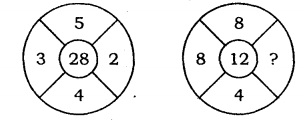
(A) 3
(B) 9
(C) 1
(D) 2
19. How many triangles are there in the following figure?
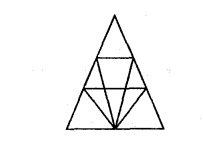
(A) 18
(C) 22
(B) 16
(D) 26
Directions for Q. Nos. 20 and 21 : A cube of side 4 cm is painted red on all of its surfaces and then divided into various smaller cubes of side 1 cm each. The smaller cubes so obtained are now separated.
20. How many smaller cubes have no face coloured?
(A) 24
(B) 16
(C) 8
(D) 10
21. How many smaller cubes will have at least two surfaces painted with red colour?
(A) 4
(B) 8
(C) 32
(D) 24
Directions for Q. Nos. 22 and 23 : Out of the four given figures, three are similar in a certain way. One figure is not like the other three. Find out the figure which does not belong to the group of three, i.e., which does not share the common characteristics with the other three figures.
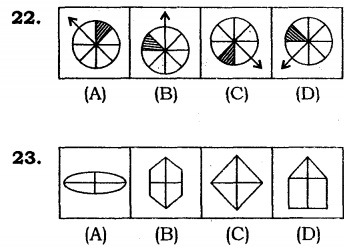
24. A dice has been thrown four times and produces the following results shown in figures (i) to (iv):

Which number will appear opposite to the number 3?
(A) 4
(B) 5
(C) 6
(D) 1
25. The figures (i)and (ii) given below show the two different positions of a dice. Which number will appear on the opposite face of number 5?
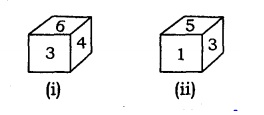
(A) 1
(B) 3
(C) 4
(D) 2









